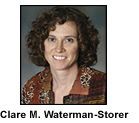BETHESDA, Md., Sept. 30 -- Clare M. Waterman-Storer, an associate professor in the department of cell biology at The Scripps Research Institute in La Jolla, Calif., has been named one of 13 recipients of the National Institute of Health's (NIH) second annual Director’s Pioneer Award. Waterman-Storer developed  a fluorescence imaging technique called fluorescence speckle microscopy and analytical methods to study how living cells change shape and move. She says she plans to use her Pioneer Award -- $500,000 a year for the next five years -- to apply these tools to correlate the interactions of multiple cellular components with biophysical outputs involved in cellular movement. Cell movement is crucial to things such as embryonic development, wound healing and the immune system's response to the presence of foreign bodies, such as cancer cells.
a fluorescence imaging technique called fluorescence speckle microscopy and analytical methods to study how living cells change shape and move. She says she plans to use her Pioneer Award -- $500,000 a year for the next five years -- to apply these tools to correlate the interactions of multiple cellular components with biophysical outputs involved in cellular movement. Cell movement is crucial to things such as embryonic development, wound healing and the immune system's response to the presence of foreign bodies, such as cancer cells. According to the NIH, the Pioneer Award supports exceptionally creative scientists who take innovative approaches to major challenges in biomedical research. The award gives recipients the intellectual freedom to pursue groundbreaking new research directions that could have significant impact if successful but that, due to their novelty or other factors, also have inherently high risks of failure.
Waterman-Storer, who is also a faculty member in the physiology course at the Marine Biological Laboratory in Woods Hole, Mass., and is an associate editor of the journals Molecular Biology of the Cell and Journal of Microscopy, was chosen from 840 scientists who underwent a rigorous self-nomination and evaluation process that began in March 2005. Criteria used to choose the winners included innovativeness and creativity, the importance of the scientific problem to be addressed and the likelihood that the project’s success would have a high impact on biomedical research. The 2005 awardees work in areas including neuroscience, genetics, epidemiology, chemistry, stem cell biology, behavioral science, infectious diseases and technology development. Six of the 13 are women and more than half are at relatively early stages of their careers (the associate professor level or below).
For more information on the 2005 NIH Director’s Pioneer Award recipients, visit: http://nihroadmap.nih.gov/pioneer/Recipients05.aspx; more information about NIH can be found at: www.nih.gov